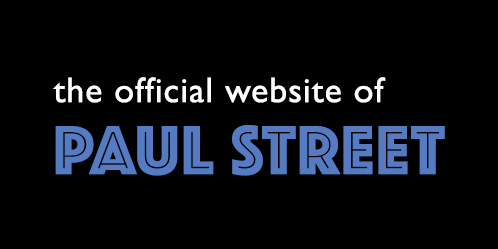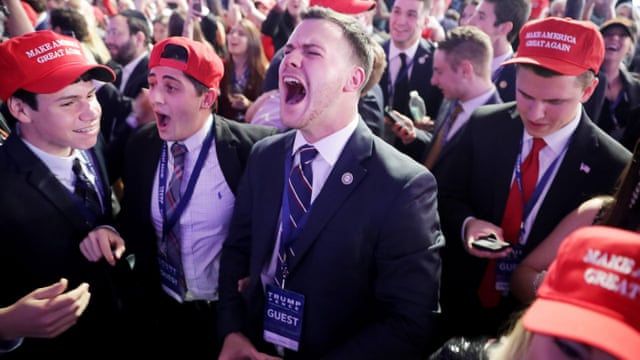Liberals have been understandably aghast at Donald Trump’s recurrent claim that he doesn’t “have a racist bone in [his] body.” Who is the white-nationalist president trying to kid? His politics and presidency have consistently been monuments to white racial identity, animated by a promise to white voters that black and brown people will be put “back in their place(s).”
A fierce “us and them” politics of unashamed whiteness, replete with the embrace of policies that discriminate against people of color, has been the primary glue holding together the Trump coalition from day one. The accurate translation of Trump’s slogan “Make America Great Again” is not so much “Make America White Again” as “Make Whites Supreme Again.”
Trump is just the tip and leading beneficiary of the big white iceberg of Amerikaner racism- denial. Ask a typical white Trump supporter if they or their clearly racist president is in any way racist and you will hear passionate denials on both counts combined with outrage that anyone would think to pose the questions in the first place.
Whence this mass white disowning of white racism? Part of it has to do with self-image. Beyond white-supremacist circles, few white Americans want to think of themselves or their loved ones, friend, and neighbors as racists in a mass culture in which racism has been given a bad name since at least the middle 1960s.
A second factor is about self-interest. Many if not most of Trump’s very disproportionately white backers know they risk alienating current and potential employers, customers, investors, listeners, viewers, voters and/or subscribers by openly embracing racist sentiments.
A third part of the equation is that many Republicans and Trumpers think they and their president are not saying or writing/tweeting/Facebooking racist things unless their statements include explicit and overt references to race and racial identity. However, much contemporary racism is cloaked in nominally race-neutral language, using technically non-racial phrases like “states’ rights,” “local control,” “law and order,” “personal responsibility,” “inner city,” “urban crime,” “welfare dependents,” “charge on taxpayers,” “super-predators,” “felons,” “illegal immigrants,” “undocumented people” and the like to confer deeply racialized meanings.
A fourth relevant factor is the widespread sense that racism is most fundamentally about interpersonal conduct and personal likes. This notion is false. Racism deeply and properly understood is about how social structures and institutions function to create outcomes that favor people of one race over and against people of other races. It’s about how housing and financial markets, the criminal justice and school funding systems, and media and electoral structures operate to perpetuate racial disparity and oppression. So what if Trump is friendly with Kanye West and Tiger Woods (and Kim Jong Un and Mohammed bin Salman) or if Joe the Plumber plays pick-up basketball with black guys? So what if your white son quarterback has a favorite wide receiver who is black on the local high school football team? So what, by the way, if you and your kids admire certain black athletes, actors, singers and/or rappers? So what even if you voted for Obama, when you back the racist War on Drugs and the mass-incarcerationist War on Drugs? Many antebellum and Jim Crow-era Southern white slaveowners and plantation owners and managers were outwardly kind to their favorite chattel and hardly meant their affection for some blacks to suggest the South’s regime of racial terrorism and exploitation should be overthrown.
By defining racism merely as a matter of how they (think they) treat nonwhite people in their daily lives (and how they embrace certain black public personalities), millions of whites get to give themselves an undeserved racial pass while backing politicians, policies and practices that consign millions of black and brown people to the bottom of the nation’s stark inequality structures.
Fifth, there’s the strange white trauma of the Obama years. In November of 2017, The Atlantic’s Adam Serwer hit on something important when he credited Trump with sensing accurately that “Obama’s time in office inflicted a profound psychological wound upon many white Americans, one that [Trump] could address by adopting a false narrative that placed the nation’s first black president outside the bounds of American citizenship. [Trump] intuited,” Serwer wrote, “that Obama’s presence in the White House decreased the value of what W.E.B. DuBois described as the ‘psychological wage’ of whiteness across all classes of white Americans, and that the path to their hearts lay in invoking a bygone past when this affront had not taken place and could not take place.” (emphasis added)
What was the affront? Serwer did not say, but he suggested the nub of the matter by invoking the great black Marxist DuBois. For DuBois, writing in the 1930s, one way the nation’s white ruling class kept the majority white working-class population at least passively allegiant to the underlying system of class rule (capitalism) was through a form of mental and emotional divide-and-rule: even the lowliest white person was guaranteed a measure of status by being deemed superior to non-whites. By holding the nation’s (and indeed the world’s) top office for two full terms, Serwer intuited, the silver-tongued Harvard Law graduate Obama had rubbed millions of white Americans (of all classes) in the face with the fact that a person from the bottom of the nation’s racial hierarchy had risen above them. This caused shame-and anger-inducing cognitive dissonance for millions of white voters, helping make them receptive to a 21st century white Redeemer like Donald Trump.
Sewer might have gone further. A fifth major factor behind white Trump voters’ racism-denial is the combination of their false belief that blacks have pulled even or even ahead of whites economically with their equally incorrect notion that whites are now major victims of racial discrimination (“reverse racism”) in the United States. The most recent comprehensive racial attitudes survey taken prior to the 2016 election by the Pew Research Center showed that less than half (47%) of white Americans understood the elementary factthat blacks were worse off financially (far worse off in that and other ways, in fact) than whites in the U.S.
These bogus white ideas, hardly new to the Obama and Trump years, have been developing across the long post-civil rights era. They are fed among other things by the dominant media-politics culture’s bourgeois-identititarian obsession with the color of faces in high places and the parade of highly successful and affluent black sports and entertainment personalities along with black political stars, including above all the nation’s 44th president, Barack Obama.
As a Chicago-based civil rights researcher and policy advocate in the early 2000s, I was deeply concerned that Obama’s ascendancy would have an ironically deadly impact on the struggle for black equality. I worried that an Obama presidency would spark precisely the DuBoisian white backlash (“white-lash”) that Serwer later sensed and that the “deeply conservative” Obama’s own victim-blaming neoliberal class-ism would merge with his fear of further triggering whites already traumatized by the simple elemental fact of his race to make him excessively unwilling to confront the nation’s racial disparities.
I feared that Obama’s captivity to Wall Street and Big Business in generalwould over-identify the cause of racial advancement with arrogant bicoastal and “heartland”-insulting neoliberal globalism and thereby feed the fake-populist flames of white reaction. I fretted that Obama’s race and technically Muslim nomenclature would help the American Empire rebrand and re-legitimize its murderous global power in the wake of George W. Bush’s disastrous (and evangelical-racist) invasion of Iraq. I worried that Obama’s dismally neoliberal and milquetoast corporatism would leave many black voters in key cities in key battleground states (Milwaukee in Wisconsin, Charlotte and Raleigh in North Carolina, Cleveland and Cincinnati in Ohio, Philadelphia and Pittsburgh in Pennsylvania, Detroit and Flint in Michigan ) wondering why they should bother to vote for the Democrats, thereby opening the door for a reactionary white fake-populist to seize the White House in 2012 or 2016.
I worried, last but not least, that an Obama presidency would be the last nail in the coffin of most of “white America’s” ability and willingness to discern and acknowledge that American racism, deeply understood, still posed steep barriers to black advancement and racial equity in the U.S. As far as many millions of white voters were already mistakenly concerned, I knew, whites were now the main victims of American racial discrimination (liberal and left, professional class-led “reverse racism”). It was an absurd belief that was only going to get more pervasive and intense with a black family in the White House. How was one supposed to tell millions of racism-denying whites that racism was still a grave American problem afflicting black and brown people when the nation’s nominally top position was held by a technically black individual in a nation that childishly measures racial equality through the narrow bourgeois lens of “diversity” at the upper reaches of its unmentionably steep social and political pyramids?
All my concerns were borne out, including the last one. The Obama presidency didn’t just undermine the psychological wage of whiteness. It also – with no small help from white nationalist right-wing politicos and media, to be sure – gave what many whites sincerely (if absurdly and ignorantly) considered maddeningly final proof positive that black folks were not only pulling equal but now unfairly moving ahead of whites. This absurd belief is a critical part of how millions of whites can claim not to be racist while actively opposing policies that might help black and brown people advance or even sustain their current positions and while supporting a president who wants to put people of color “back in their place.” After all, these white people have been led to preposterously think that the main thrust of racism is directed now against them and that it is therefore racist to suggest that they are racists.
It’s Orwellian, as in Black is White and 2+2=5. But it is what it is, and it is no small part of how the United States has experienced two and three-quarter years of a sloppy but in-power palingenetic white nationalism that carries no small whiff of neofascism. And it’s only going to get worse.

